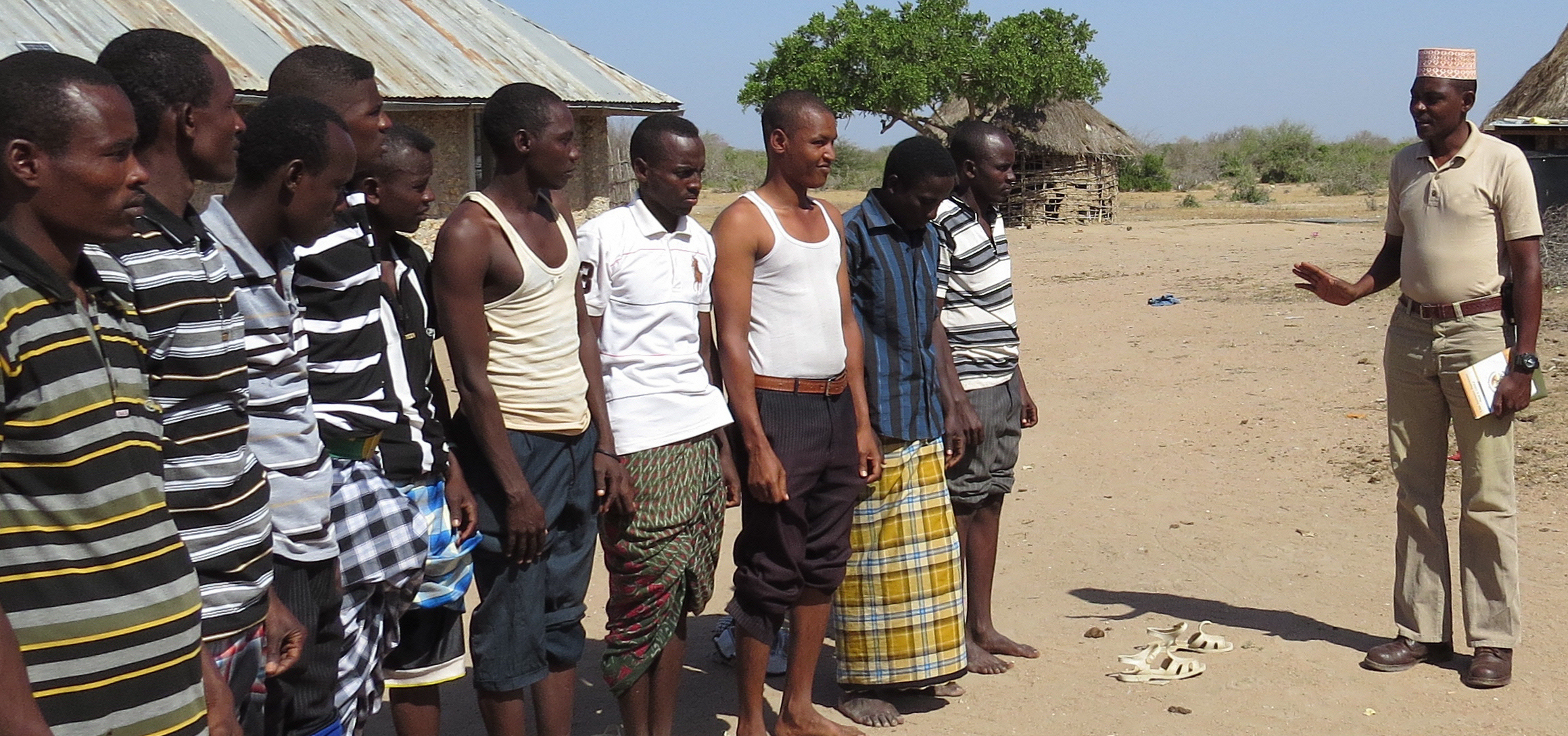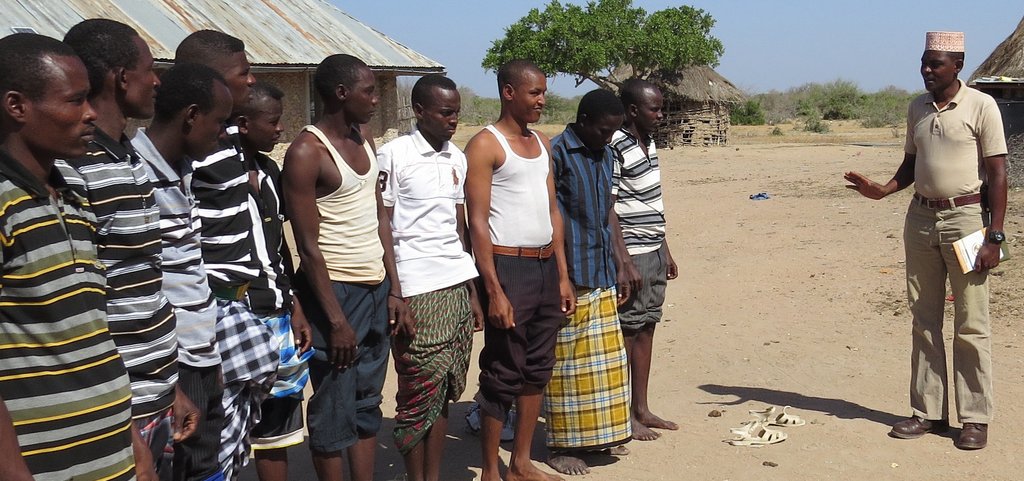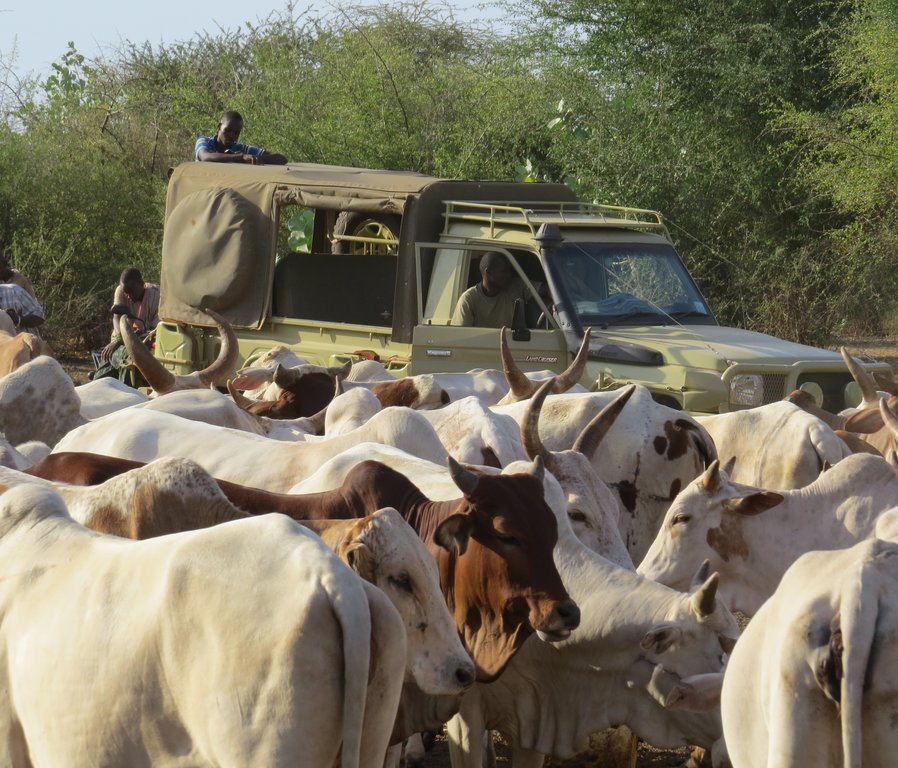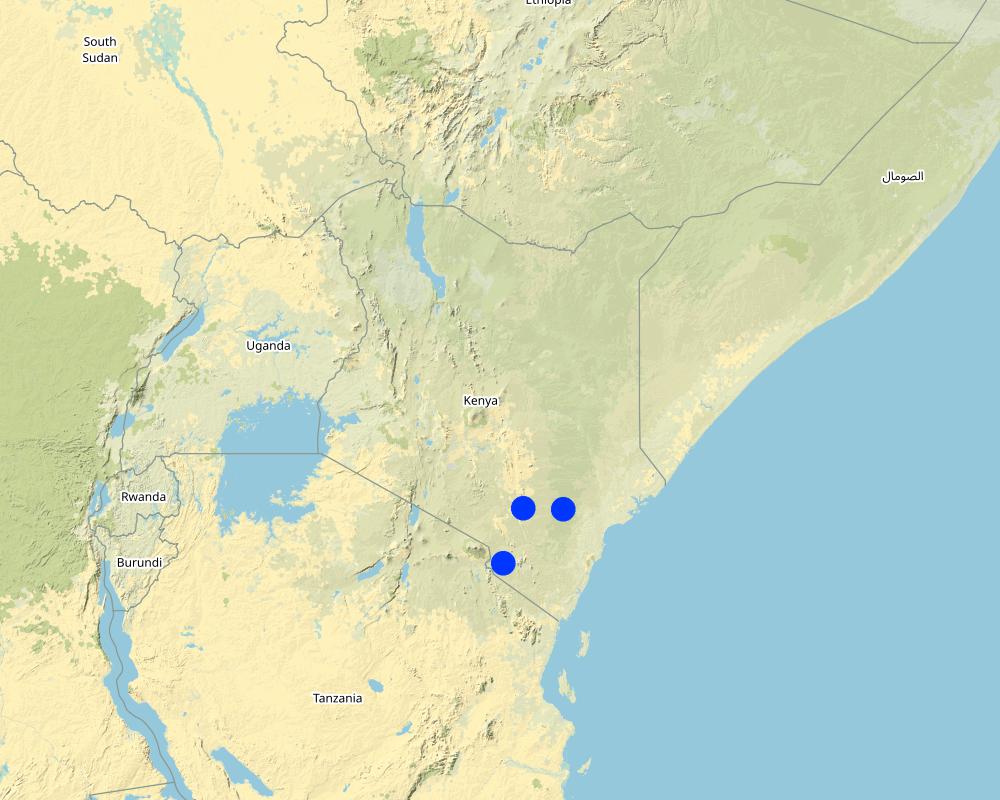Stabilization Through Conservation ('StabilCon') approach [ເຄັນຢາ]
- ການສ້າງ:
- ປັບປູງ:
- ຜູ້ສັງລວມຂໍ້ມູນ: Harry Wells
- ບັນນາທິການ: –
- ຜູ້ທົບທວນຄືນ: Donia Mühlematter, Hanspeter Liniger, Rima Mekdaschi Studer, Joana Eichenberger
approaches_3615 - ເຄັນຢາ
ເບິ່ງພາກສ່ວນ
ຂະຫຍາຍທັງໝົດ ຍຸບທັງໝົດ1. ຂໍ້ມູນທົ່ວໄປ
1.2 ລາຍລະອຽດ ການຕິດຕໍ່ ຂອງບຸກຄົນທີ່ຊັບພະຍາກອນ ແລະ ສະຖາບັນ ການມີສ່ວນຮ່ວມ ໃນການປະເມີນຜົນ ແລະ ເອກະສານ ຂອງວິທີທາງ
ບຸກຄົນສຳຄັນ (ຫຼາຍຄົນ)
Protected Area Manager:
ຊື່ຂອງໂຄງການ ທີ່ອໍານວຍຄວາມສະດວກ ໃນການສ້າງເອກກະສານ ຫຼື ປະເມີນດ້ານແນວທາງ (ຖ້າກ່ຽວຂ້ອງ)
Book project: Guidelines to Rangeland Management in Sub-Saharan Africa (Rangeland Management)1.3 ເງື່ອນໄຂ ຂອງການນໍາໃຊ້ເອກກະສານຂໍ້ມູນ ຂອງ WOCAT
ເມື່ອໃດທີ່ໄດ້ສັງລວມຂໍ້ມູນ (ຢູ່ພາກສະໜາມ)?
16/04/2018
ຜູ້ສັງລວມ ແລະ ບັນດາຜູ້ຕອບແບບສອບຖາມ ຍອມຮັບໃນເງື່ອນໄຂ ການນໍາໃຊ້ຂໍ້ມູນເອກະສານ ທີ່ສ້າງຂື້ນ ໂດຍຜ່ານ ອົງການ WOCAT:
ແມ່ນ
2. ພັນລະນາ ແນວທາງການຄຸ້ມຄອງນໍາໃຊ້ດິນແບບຍືນຍົງ
2.1 ການອະທິບາຍ ໂດຍຫຍໍ້ ຂອງວິທີທາງ
The 'StabilCon' approach is a non-aggressive, low-intensity stabilization model that seeks to reconcile the needs of both humans and their natural environment. To achieve this, StabilCon aims to co-develop two mutually beneficial elements: sustainable natural resource management and human security in rural areas.
2.2 ການອະທິບາຍ ລາຍລະອຽດ ຂອງວິທີທາງ
ການອະທິບາຍ ລາຍລະອຽດ ຂອງວິທີທາງ:
StabilCon is a holistic approach that seeks to develop social-ecosystems that accept wildlife and respect natural resources, in order to address complex conservation challenges. Implemented by rural communities, in partnership with local stewardship organizations, such as Tsavo Conservation Group, StabilCon aims to build human and natural resource security. StabilCon also aims to shift the human-wildlife relationship from conflict towards a symbiotic relationship with mutual benefits. The approach is based on the premise that unstable environments (whether due to human, economic or environmental factors) preclude any conservation, sustainable development or natural resource management initiative. Therefore, StabilCon seeks to build institutional capacity in rural communities to achieve four interrelated goals: 1) Support the rule of law (e.g. through training of community rangers) to reduce physical insecurity for humans, wildlife and natural resources to manageable levels as a mandatory first step; 2) Use this security as a foundation on which to build and diversify nature-based economic opportunities (e.g. reduced wildlife poaching facilitates the development of tourism-based economic opportunities, while greater local security can also benefit livestock-keeping by reducing the incidents of stock thefts); 3) Strengthen environmental security to enable benefits of biodiversity conservation and healthy ecosystems to be shared by current and future generations; 4) Develop more robust, equitable and representative community governance system, aligned with county and national government agencies and their objectives (e.g. through governance training within rural communities).
StabilCon aims to use these four interrelated goals to develop a foundation of long-term environmental security and create circumstances conducive to socio-economic progress of rural communities. Activities are conducted by the StabilCon Implementation Unit (SIU), which in the Tsavo Model is composed of 5 members: 1) CEO & co-founder of Tsavo Conservation Group (TsavoCon) - responsibilities include managing TsavoCon's strategic direction through StabilCon, developing & managing strategic relationships, working with Kenya's national and county governments and US government, international fund raising; 2) TsavoCon Chief Financial Officer - Taita Taveta born and a member of the Association of Chartered Accountants (London) who leads human resources issues and is responsible for financial operations (e.g. opening bank accounts for full time staff, introducing and managing accounting software); 3) Operations Officer - supports CEO in developing strategic relationships (e.g. liaison with Taita Conservancy elders, county government officials, NGO partners) and is a Geographic Information System analyst developing a map database (e.g. elephant poaching data); 4) Liaison Officer - responsible for engagement with Orma community members of Malkahalaku Community Conservancy as well as liaison with local and national government officials, and to manage the conservancy's rangers (he was formerly an instructor with the Kenya Wildlife Service); 5) TsavoCon Pilot - responsibilities include managing aerial observation operations, TsavoCon vehicles, communications, resupply & logistics of TsavoCon assets in the field.
2.3 ຮູບພາບຂອງແນວທາງ
2.5 ປະເທດ / ເຂດ / ສະຖານທີ່ບ່ອນທີ່ແນວທາງໄດ້ຖືກນໍາໃຊ້
ປະເທດ:
ເຄັນຢາ
ຂໍ້ມູນເພີ່ມເຕີມຂອງສະຖານທີ່:
Greater Tsavo Ecosystem
ຄວາມຄິດເຫັນ:
For more details see: http://www.tsavocon.org/
Map
×2.6 ວັນທີເລີ່ມຕົ້ນ ແລະ ສິ້ນສຸດ ການຈັດຕັ້ງປະຕີບັດ ວິທີທາງ
ສະແດງປີຂອງການເລີ່ມຕົ້ນ:
2016
ຖ້າຫາກບໍ່ຮູ້ຈັກປີທີ່ແນ່ນອນ, ໃຫ້ປະມານຄາດຄະເນ ເອົາມື້ທີ່ໄດ້ເລີ່ມຈັດຕັ້ງປະຕິບັດ ວິທີທາງ:
ຕໍ່າກວ່າ 10 ປີ ຜ່ານມາ (ມາເຖິງປະຈຸບັນ)
2.7 ປະເພດຂອງແນວທາງ
- ການລິເລີ່ມ ພາຍໃນປະເທດ ທີ່ຜ່ານມາ / ນະວັດຕະກໍາ
2.8 ເປົ້າໝາຍ / ຈຸດປະສົງຫຼັກ ຂອງການຈັດຕັ້ງປະຕິບັດ ວິທີທາງ
StabilCon seeks to build institutional capacity in rural communities to achieve four interrelated goals:
1) Effective security, law and order - Support the rule of law to reduce physical insecurity for humans, wildlife and natural resources to manageable levels as a mandatory first step to enable the other three goals;
2) Economic security - Use this security as a foundation on which to build and diversify nature-based economic opportunities (e.g. livestock and tourism);
3) Environmental security - Strengthen environmental security to enable benefits of biodiversity conservation and healthy ecosystems to be shared by current and future generations;
4) Social security - Develop more robust, equitable and representative community governance system, aligned with county and national government agencies and their objectives.
2.9 ເງື່ອນໄຂອໍານວຍ ຫຼື ຂັດຂວາງການປະຕິບັດຂອງເຕັກໂນໂລຢີ / ເຕັກໂນໂລຢີການນໍາໃຊ້ຕາມແນວທາງ
ສັງຄົມ / ວັດທະນະທໍາ / ມາດຕະຖານ ແລະ ຄຸນຄ່າທາງສາສະໜາ
- ອໍານວຍ
Livestock, water and security are already top priorities for local communities and are in alignment with StabilCon's objectives.
- ເຊື່ອງຊ້ອນ
Rural communities, limited in their access to education, find it difficult to navigate the bureaucratic processes involved in securing funding.
ມີຄວາມສາມາດ / ເຂັ້າເຖິງຊັບພະຍາກອນດ້ານການເງິນ ແລະ ການບໍລິການ
- ອໍານວຍ
USAID and other donors assist greatly by funding StabilCon's activities.
ການຮ່ວມມື / ການປະສານງານຂອງຜູ້ກ່ຽວຂ້ອງ
- ອໍານວຍ
The improved relationship between the Malkahalaku community and the Kenya Wildlife Service (national government), facilitated by StabilCon's Implementation Unit (SIU), has been beneficial particularly in conflict mitigation.
- ເຊື່ອງຊ້ອນ
Dysfunctional relationships among local chiefs and between Malkahalau community and the Kenya Wildlife Service (KWS) were initially hindering. In addition, almost every year, heightened competition over fodder/water for livestock between pastoralists and agriculturalists and between neighbouring pastoral communities lead to conflicts, which are often violent. Previously, the dysfunctional relationship between Malkahalaku community and KWS led to confrontations and destruction of KWS infrastructure. On one occasion, KWS rangers posted in the community were chased out by community members and the KWS ranger post burnt down by community members.
ກ່ຽວກັບກົດໝາຍ (ສິດນໍາໃຊ້ດິນ, ສິດນໍາໃຊ້ນໍ້າ)
- ອໍານວຍ
The official conservancy status given when the Malkahalaku Community Conservancy was established in 2015 was crucial in providing land tenure security. This stronger land tenure security has been instrumental in NRM through resolving conflicts with neighbouring communities over access to grazing/water.
ນະໂຍບາຍ
- ອໍານວຍ
The Wildlife Act has been particularly beneficial through its support of conservation activities. The Act emphasises effective public participation in the management of wildlife resources, thereby setting a basis for the strengthening of community based NRM.
ການປົກຄອງທີ່ດິນ (ການຕັດສິນໃຈ, ການປະຕິບັດ ແລະ ຂໍ້ບັງຄັບ)
- ເຊື່ອງຊ້ອນ
Poor law enforcement in rural areas leads to social insecurity at the community level. This impacts many aspects of NRM including illegal wildlife poaching and armed conflicts between pastoralist groups over access to grazing/water.
ຄວາມຮູ້ກ່ຽວກັບການຄຸ້ມຄອງ ທີ່ດິນແບບຍືນຍົງ, ການເຂົ້າເຖິງການສະໜັບສະໜູນ ທາງດ້ານວິຊາການ
- ອໍານວຍ
StabilCon aims to integrate the extensive local knowledge relating to pastoralism among Oromo people. However, traditional livestock management practices are also evolving and the Oromo are moving towards reducing livestock numbers and raising livestock quality (similar to the ranching approach).
- ເຊື່ອງຊ້ອນ
Some previous local pastoral practices are no longer applicable to the changing environment, particularly with regard to quality and number of livestock, but practices are changing. For example, the shift from emphasis on the number of livestock owned towards smaller herd sizes and higher quality livestock.
ຕະຫຼາດ (ໃນການຊື້ວັດຖຸດິບ, ຂາຍຜະລິດຕະພັນ) ແລະ ລາຄາ
- ເຊື່ອງຊ້ອນ
Importing meat from neighbouring countries (e.g. Tanzania, Uganda) floods Kenya's market, leading to a poor economic environment for local livestock production. StabilCon is currently planning to improve Malkahalaku Community Conservancy's access to national beef markets that will provide more favourable prices for the community's members.
ວຽກ, ມີກໍາລັງຄົນ
- ເຊື່ອງຊ້ອນ
StabilCon has a small team, but their dedication helps compensate for the limited man hours.
ອື່ນໆ
- ເຊື່ອງຊ້ອນ
Social insecurity is one of the main barriers and it is exacerbated by climatic changes. More specifically, shifts in patterns and temporal distribution of rainfall pose challenges even for highly mobile pastoralists. During drought periods, heightened competition over grazing and water intensify human conflict. These conflicts over basic resources preclude NRM activities.
3. ການມີສ່ວນຮ່ວມ ແລະ ບົດບາດຂອງພາກສ່ວນທີ່ກ່ຽວຂ້ອງທີ່ໄດ້ມີສ່ວນຮ່ວມ
3.1 ຜູ້ມີສ່ວນຮ່ວມ ໃນວິທີທາງ ແລະ ພາລະບົດບາດ ຂອງເຂົາເຈົ້າ
- ຜູ້ນໍາໃຊ້ດິນໃນທ້ອງຖິ່ນ / ຊຸມຊົນທ້ອງຖິ່ນ
Taita Taveta Wildlife Conservancies Association and Malkahalaku Community Conservancy.
In the Taita area, Taita Taveta Wildlife Conservancies Association is the main local institutional actor, as it represents all 28 conservancies in the area (a large number of community members sign up to be part of one or more conservancies). In the Tana River County area, Malkahalaku Community Conservancy is the main institutional actor.
- ຜູ້ຊ່ຽວຊານ ການນຄຸ້ມຄອງ ທີ່ດິນແບບຍືນຍົງ / ທີ່ປຶກສາດ້ານກະສິກໍາ
Tsavo Conservation Group (TsavoCon). TsavoCon is composed of four members: CEO (an experienced protected area manager and leader of international relations; degree in Wildlife Conservation Management), Tana River County Coordinator (paramilitary-trained with experienced in wildlife conservation/anti-poaching; diploma in Wildlife Sanctuary Management), Taita Taveta County Coordinator (experienced wildlife conservationist and former CEO of Taita Taveta Wildlife Conservancies), Chief Financial Officer (experienced in conservation-focused non-profit management).
In the Tsavo Model of StabilCon, TsavoCon is the main facilitating organization, providing a link between local communities, livestock and rangeland management experts and international funding organisations. TsavoCon acts as the StabilCon Implementation Unit (SIU) in the Greater Tsavo Ecosystem.
- ນັກຄົ້ນຄວ້າ
Geographic Information System specialist.
This researcher compiles data collected by StabilCon on poaching and insecurity. Tracking trends in elephant poaching as an indicator of increased security is one of the ways in which these data are used.
- ອົງການຈັດຕັ້ງ ທີ່ບໍ່ຂື້ນກັບລັດຖະບານ
Global Environmental Facility, African Wildlife Foundation, Wildlife Works.
These NGO's fund StabilCon's activities and/or act as conservation partners of Tsavo Conservation Group.
- ອໍານາດ ການປົກຄອງທ້ອງຖິ່ນ
These include: the county environmental minister and their department; the county minister of lands; the county minister of livestock; the chairman of conservation compensation committee.
These actors are involved in allocation of local government support for community-level projects.
- ພະນັກງານຂັ້ນສູນກາງ (ຜູ້ວາງແຜນ, ຜູ້ສ້າງນະໂຍບາຍ)
Kenya Wildlife Service (KWS), County Security Committee (national security apparatus)
These actors are mandated national security agencies. KWS's Law Enforcement Academy trained 22 members of Malkahalaku Community Conservancy (funded by Tsavo Conservation Group), who are now rangers for the conservancy. These rangers patrol their conservancy, increasing human security and reducing poaching. During droughts, KWS allow Malkahalaku Community Conservancy livestock to graze in Tsavo East National Park to relieve pressure on the community and diffuse conflicts over fodder/water. In Kenya, this is a relatively common but controversial practice as it puts pressure on the land within the protected area and potentially increases herd sizes and overall grazing pressure, particularly over the long term.
- ອົງການຈັດຕັ້ງ ສາກົນ
USAID, Global Environment Facility, African Wildlife Foundation, Wildlife Works
Funding and/or Tsavo Conservation Group conservation partners.
ຖ້າຫາກມີຫຼາຍພາກສ່ວນທີ່ເຂົ້າຮ່ວມ ໃຫ້ລະບຸ ອົງການທີ່ເປັນຫຼັກ ໃນການຈັດຕັ້ງປະຕິບັດ:
In the Tsavo model of StabilCon, Tsavo Conservation Group fulfils the role of StabilCon Implementation Unit (SIU), and is the lead facilitator and coordinator in the Greater Tsavo Ecosystem.
3.2 ການມີສ່ວນຮ່ວມຂອງຜູ້ນໍາໃຊ້ທີ່ດິນໃນທ້ອງຖິ່ນ / ຊຸມຊົນທ້ອງຖິ່ນໃນໄລຍະທີ່ແຕກຕ່າງກັນຂອງແນວທາງ
| ການລວບລວມ ເອົາຜູ້ນໍາໃຊ້ດິນ ໃນທ້ອງຖິ່ນ / ຊຸມຊົນທ້ອງຖິ່ນ | ໃຫ້ລະບຸ ຜູ້ໃດທີ່ມີສ່ວນຮ່ວມ ໃນແຕ່ລະກິດຈະກໍາ? | |
|---|---|---|
| ການເລີ່ມຕົ້ນ / ແຮງຈູງໃຈ | ການຮ່ວມມື | Under the StabilCon approach, international and local actors are involved in the initiation phase but it leads towards self mobilization. |
| ການວາງແຜນ | ການຮ່ວມມື | The StabilCon Implementation Unit (composed of a coordinator, experts/professionals and local actors) leads the planning phase, which includes an area identification and a ground feasibility study. |
| ການປະຕິບັດ | ການນໍາໃໍຊ້ເອງ | All activities are implemented by local communities. |
| ຕິດຕາມກວດກາ / ການປະເມີນຜົນ | ການຊ່ວຍເຫຼືອຈາກພາຍນອກ | Data is mainly collected and analyzed by specialists/experts. |
3.3 ແຜນວາດ (ຖ້າມີ)
3.4 ການຕັດສິນໃຈກ່ຽວກັບການຄັດເລືອກເຕັກໂນໂລຢີຂອງການຄຸ້ມຄອງທີ່ດິນແບບຍືນຍົງ / ເຕັກໂນໂລຢີ
ລະບຸ ຄົນທີ່ຕັດສິນໃຈ ກ່ຽວກັບການຄັດເລືອກຂອງ ເຕັກໂນໂລຢີ / ເຕັກໂນໂລຢີ ຈະໄດ້ຮັບການປະຕິບັດ:
- ຜູ້ນໍາໃຊ້ທີ່ດິນຫຼັກ, ການສະໜັບສະໜູນ ໂດຍຜູ້ຊ່ຽວຊານ ການນໍາໃຊ້ທີ່ດິນແບບຍືນຍົງ
ອະທິບາຍ:
StabilCon aims to bring together international SLM experience with local SLM knowledge to develop activities.
Specify on what basis decisions were made:
- ປະເມີນເອກກະສານ ຄວາມຮູ້ກ່ຽວກັບ ການຄຸ້ມຄອງ ທີ່ດິນແບບຍືນຍົງ (ຫຼັກຖານທີ່ຊ່ວຍໃນການຕັດສິນໃຈ)
- ປະສົບການສ່ວນບຸກຄົນ ແລະ ຄວາມຄິດເຫັນ (ທີ່ບໍ່ເປັນເອກກະສານ)
4. ການສະໜັບສະໜູນທາງດ້ານວິຊາການ, ການສ້າງຄວາມສາມາດ, ແລະ ການຈັດການຄວາມຮູ້.
4.1 ການສ້າງຄວາມສາມາດ / ການຝຶກອົບຮົມ
ຜູ້ນໍາໃຊ້ທີ່ດິນ ຫຼື ພາກສ່ວນກ່ຽວຂ້ອງອື່ນໆ ໄດ້ຮັບການຝຶກອົບຮົມບໍ່?
ແມ່ນ
ໃຫ້ລະບຸ ຜູ້ໃດທີ່ໄດ້ຮັບການຝຶກອົບຮົມ:
- ຜູ້ນໍາໃຊ້ດິນ
- local government (e.g. accounting, legal, economic)
ຮູບແບບຂອງການຝຶກອົບຮົມ:
- ການເຮັດຕົວຈິງ
- ຫຼັກສູດ
ໃນຫົວຂໍ້:
22 members of the Malkahalaku Community Conservancy were trained through a Kenya Wildlife Service Law Enforcement Academy programme, to enable them to serve as rangers for their conservancy to improve local security. The StabilCon implementation Unit also conducted courses to train the Conservancy's management and employees in various offices (e.g. accounting, legal, economic) to improve governance in Malkahalaku Community Conservancy.
4.2 ການບໍລິການໃຫ້ຄໍາປຶກສາ
ເຮັດຜູ້ໃຊ້ທີ່ດິນມີການເຂົ້າເຖິງການບໍລິການໃຫ້ຄໍາປຶກສາ?
ແມ່ນ
- Depends on who is receiving the advice.
ອະທິບາຍ / ຄວາມຄິດເຫັນ:
StabilCon Implementation Unit (SIU) provides advice to individuals at multiple levels from government to local.
4.3 ສະຖາບັນການສ້າງຄວາມເຂັ້ມແຂງ (ການພັດທະນາອົງການຈັດຕັ້ງ)
ສະຖາບັນ ໄດ້ຮັບການສ້າງຕັ້ງຂື້ນ ຫຼື ໄດ້ຮັບການສ້າງຄວາມເຂັ້ມແຂງ ໂດຍການຈັດຕັ້ງປະຕິບັດ ວິທີທາງບໍ່?
- ມີ, ຫຼາຍ
ລະບຸ ທາງສະຖາບັນ ໄດ້ສ້າງຄວາມເຂັ້ມແຂງ ໃນລະດັບໃດ (ຫຼາຍ):
- ທ້ອງຖິ່ນ
- ລະດັບພາກພື້ນ
- ແຫ່ງຊາດ
ອະທິບາຍ ສະຖາບັນການຈັດຕັ້ງ, ພາລະບົດບາດ ແລະ ໜ້າທີ່ຮັບຜິດຊອບ, ສະມາຊິກ ແລະ ອື່ນໆ.
Tsavo Conservation Group, as the StabilCon Implementation Unit (SIU), liaise with all stakeholders to develop an integrated landscape security model in Taita
ລະບຸ ປະເພດ ຂອງສະໜັບສະໜູນ:
- ທາງດ້ານການເງິນ
- ການສ້າງຄວາມອາດສາມາດ / ການຝຶກອົບຮົມ
ໃຫ້ລາຍລະອຽດເພີ່ມເຕີມ:
The Kenya Wildlife Service is due to train 40 Taita community rangers at their Law Enforcement Academy, funded by USAID in conjunction with Tsavo Conservation Group.
4.4 ຕິດຕາມກວດກາ ແລະ ປະເມີນຜົນ
ການຈັດຕັ້ງປະຕິບັດ ວິທີທາງ ໄດ້ມີການປະເມີນຜົນ ແລະ ຕິດຕາມບໍ?
ບໍ່ແມ່ນ
ຄວາມຄິດເຫັນ:
The StabilCon approach relies on accurate data to inform decision making. Tsavo Conservation Group maintains a rigorous monitoring and evaluation procedure and maps human-wildlife conflict and rural human dynamics affecting the natural environment in its focal area.
4.5 ການຄົ້ນຄວ້າ
ນີ້້ແມ່ນສ່ວນໜຶ່ງ ການຄົ້ນຄວ້າ ຂອງວິທີທາງບໍ່?
ບໍ່ແມ່ນ
5. ການສະໜັບສະໜູນທາງດ້ານການເງິນ ແລະ ອຸປະກອນຈາກພາຍນອກ
5.1 ງົບປະມານປະຈໍາປີ ສໍາລັບວິທີທາງ ຂອງການຄຸ້ມຄອງ ທີ່ດິນແບບຍືນຍົງ
ຖ້າຫາກບໍ່ຮູ້ຈັດງົບປະມານທີ່ແນ່ນອນ ແມ່ນໃຫ້ປະມານເອົາ:
- 100,000-1,000,000
ຄໍາເຫັນ (ຕົວຢ່າງ: ແຫຼ່ງຂໍ້ມູນຫຼັກ ຂອງການສະໜອງທຶນ / ຜູ້ໃຫ້ທຶນທີ່ສໍາຄັນ):
USAID and private donors are the main funding sources.
5.2 ການສະໜັບສະໜູນ ທາງດ້ານການເງິນ / ອຸປະກອນ ສະໜອງໃຫ້ແກ່ຜູ້ນໍາທີ່ດິນ
ຜູ້ນໍາໃຊ້ດິນ ໄດ້ຮັບການສະໜັບສະໜູນ ທາງດ້ານ ການເງິນ / ອຸປະກອນ ໃນການຈັດຕັ້ງປະຕິບັດ ເຕັກໂນໂລຢີບໍ?
ແມ່ນ
ຖ້າແມ່ນ, ໃຫ້ລະບຸປະເພດ (ຫຼາຍ) ຂອງການສະໜັບສະໜູນ, ເງື່ອນໄຂ ແລະ ຜູູ້ສະໜອງ (ຫຼາຍ):
Tsavo Conservation Group raises external funding for rangers (training, salaries etc.), security infrastructure (buildings, vehicles etc.); logistics, planning and deployment costs. However, the StabilCon approach aims to make all activities economically self-sustaining through internal funding.
5.3 ເງິນສົມທົບສໍາລັບການນໍາໃຊ້ສະເພາະປັດໃຈຂາເຂົ້າໃນການຜະລີດກະສິກໍາ (ລວມທັງແຮງງານ)
- ບໍ່ມີ
ຖ້າແຮງງານ ຂອງຜູ້ນໍາໃຊ້ດິນ ໄດ້ຮັບການສະໜັບສະໜູນ ປັດໃຈຂາເຂົ້າ, ແມ່ນບໍ່:
- ຈ່າຍເປັນເງິນສົດ
ຄວາມຄິດເຫັນ:
Conservancy rangers are paid in cash through StabilCon, but these costs will gradually be internalized.
5.4 ສິນເຊື່ອ
ໄດ້ປ່ອຍສິນເຊື່ອ ສະໜອງໃຫ້ພາຍໃຕ້ ວິທີການສໍາລັບກິດຈະກໍາ ການຄຸ້ມຄອງ ທີ່ດິນແບບຍືນນຍົງບໍ່?
ບໍ່ແມ່ນ
5.5 ສິ່ງຈູງໃຈ ຫຼື ເຄື່ອງມືອື່ນໆ
ການສົ່ງເສີມ ຈັດຕັ້ງປະຕິບັດ ເຕັກໂນໂລຢີ ໃນການຄຸ້ມຄອງ ດິນແບບຍືນຍົງ ໄດ້ສະໜອງສິ່ງກະຕຸກຊຸກຍູ້ບໍ່?
ບໍ່ແມ່ນ
6. ວິເຄາະຜົນກະທົບ ແລະ ສັງລວມບັນຫາ
6.1 ຜົນກະທົບຂອງແນວທາງ
ວິທີທາງ ຊ່ວຍຊຸກຍູ້ ຜູ້ນຳໃຊ້ທີ່ດິນທ້ອງຖີ່ນ, ໃນການປັບປຸງ ການມີສ່ວນຮ່ວມ ຂອງຜູ້ທີ່ກ່ຽວຂ້ອງ ບໍ່?
- ບໍ່
- ມີ, ໜ້ອຍໜຶ່ງ
- ມີ, ພໍສົມຄວນ
- ມີ, ຫຼາຍ
The training of community conservancy rangers enables the conservancies to increase the degree to which they manage their own security, and are less dependent on already overstretched government law enforcement agencies.
ການຈັດຕັ້ງປະຕິບັດ ວິທີທາງ ສາມາດຊ່ວຍຜູ້ນໍາໃຊ້ທີ່ດິນ ໃນການຈັດຕັ້ງປະຕິບັດ ແລະ ບໍາລຸງຮັກສາ ເຕັກໂນໂລຢີ ການຄຸ້ມຄອງ ທີ່ດິນແບບຍືນຍົງໄດ້ບໍ?
- ບໍ່
- ມີ, ໜ້ອຍໜຶ່ງ
- ມີ, ພໍສົມຄວນ
- ມີ, ຫຼາຍ
Data collected thus far indicates that elephant poaching has declined considerably since StabilCon's implementation, but it is not yet possible to gauge the sustainability due to the short duration of operation.
ການນໍາໃຊ້ ວິທີທາງ ສາມາດປັບປຸງ ການປະສານງານ ແລະ ຄ່າໃຊ້ຈ່າຍ ການຈັດຕັ້ງປະຕິບັດ ທີ່ມີປະສິດທິພາບ ຂອງການຄຸ້ມຄອງ ທີ່ດິນແບບຍືດຍົງໄດ້ບໍ່?
- ບໍ່
- ມີ, ໜ້ອຍໜຶ່ງ
- ມີ, ພໍສົມຄວນ
- ມີ, ຫຼາຍ
By acting as an impartial arbitrator, the StabilCon Implementation Unit facilitated coordination between chiefs who previously had dysfunctional relationships.
ການນໍາໃຊ້ ວິທີທາງ ສາມາດລະດົມ ຫຼື ປັບປຸງ ການເຂົ້າເຖິງຊັບພະຍາກອນ ການເງິນ ສໍາລັບການຈັດຕັ້ງປະຕິບັດ ການຄຸ້ມຄອງ ທີ່ດິນແບບຍືດຍົງໄດ້ບໍ່?
- ບໍ່
- ມີ, ໜ້ອຍໜຶ່ງ
- ມີ, ພໍສົມຄວນ
- ມີ, ຫຼາຍ
StabilCon raised funding from international organizations such as USAID, that would otherwise have been inaccessible to local people.
ການນໍາໃຊ້ ວິທີທາງ ສາມາດປັບປຸງຄວາມຮູ້ ແລະ ຄວາມສາມາດ ຂອງພາກສ່ວນທີ່ກ່ຽວຂ້ອງໄດ້ບໍ່?
- ບໍ່
- ມີ, ໜ້ອຍໜຶ່ງ
- ມີ, ພໍສົມຄວນ
- ມີ, ຫຼາຍ
Capacity building was provided to local government employees (e.g. accountants, legal, economic). It was also provided to conservancy members in the form of ranger training.
ການນໍາໃຊ້ ວິທີທາງ ສາມາດສ້າງຄວາມເຂັ້ມແຂງ ໃຫ້ສະຖາບັນການຈັດຕັ້ງ, ການຮ່ວມມື ລະຫວ່າງພາກສ່ວນທີ່ກ່ຽວຂ້ອງບໍ່?
- ບໍ່
- ມີ, ໜ້ອຍໜຶ່ງ
- ມີ, ພໍສົມຄວນ
- ມີ, ຫຼາຍ
StabilCon facilitated collaboration among actors who previously did not coordinate at local-level (chiefs) and government-level (government departments).
ການນໍາໃຊ້ ວິທີທາງ ສາມາດຫຼຸດຜ່ອນ ຂໍ້ຂັດແຍ່ງໄດ້ບໍ່?
- ບໍ່
- ມີ, ໜ້ອຍໜຶ່ງ
- ມີ, ພໍສົມຄວນ
- ມີ, ຫຼາຍ
The StabilCon Implementation Unit helped mitigate conflicts between Malkahalaku Community members and the Kenya Wildlife Service (national government) by facilitating dialogue and acting as third party mediators.
ການນໍາໃຊ້ ວິທີທາງ ໄດ້ປັບປຸງ ການນໍາໃຊ້ແຫຼ່ງພະລັງງານ ແບບຍືນຍົງຫຼາຍຂື້ນບໍ່?
- ບໍ່
- ມີ, ໜ້ອຍໜຶ່ງ
- ມີ, ພໍສົມຄວນ
- ມີ, ຫຼາຍ
No energy source dimension to the approach.
ການຈັດຕັ້ງປະຕິບັດ ວິທີທາງ ສາມາດສ້າງຄວາມອາດສາມາດໃຫ້ຜູ້ນໍາໃຊ້ດິນ ໃນການປັບຕົວ ຕໍ່ການປ່ຽນແປງດິນຟ້າອາກາດ / ຫຼດຜ່ອນຄວາມສ່ຽງທາງໄພພິບັດໄດ້ບໍ? :
- ບໍ່
- ມີ, ໜ້ອຍໜຶ່ງ
- ມີ, ພໍສົມຄວນ
- ມີ, ຫຼາຍ
As StabilCon has only been active for 3 years this is difficult to judge.
ການນໍາໃຊ້ ວິທີທາງ ໄດ້ປັບປຸງ ການຈ້າງງານ, ໂອກາດ ໃນການສ້າງລາຍຮັບບໍ່?
- ບໍ່
- ມີ, ໜ້ອຍໜຶ່ງ
- ມີ, ພໍສົມຄວນ
- ມີ, ຫຼາຍ
StabilCon created job opportunities relating to conservancy security (mainly rangers).
6.2 ແຮງຈູງໃຈຫຼັກຂອງຜູ້ນໍາໃຊ້ທີ່ດິນໃນການປະຕິບັດການຄຸ້ມຄອງທີ່ດິນແບບຍືນຍົງ
- ກໍາໄລເພີ່ມຂຶ້ນ (ຄວາມສາມາດ), ການປັບປຸງຄ່າໃຊ້ຈ່າຍ, ຜົນປະໂຫຍດ, ອັດຕາສ່ວນ
Wealth and a better life are the main motivations for all activities.
- ກົດລະບຽບແລະລະບຽບການ (ລະອຽດ) / ການບັງຄັບໃຊ້
Law enforcement at the community level in rural communities is one of the main benefits of formally trained conservancy rangers.
- ການຫຼຸດຜ່ອນຂໍ້ຂັດແຍ່ງ
Conflict mitigation is a significant aspect of this approach. The presence of formally trained rangers benefits community members in the form of improved social security and possibly economic opportunities (e.g. less wildlife poaching may improve tourism and fewer stock thefts may facilitate livestock-keeping).
6.3 ຄວາມຍືນຍົງຂອງກິດຈະກໍາວິທີທາງ
ຜູ້ນໍາໃຊ້ ທີ່ດິນ ສາມາດສືບຕໍ່ ການຈັດຕັ້ງປະຕິບັດ ຜ່ານວິທີທາງໄດ້ບໍ່ (ໂດຍປາດສະຈາກ ການຊ່ວຍເຫຼືອ ຈາກພາກສ່ວນພາຍນອກ)?
- ບໍ່ແນ່ນອນ
ຖ້າ ບໍ່ ຫຼື ບໍ່ແນ່ໃຈ, ໃຫ້ອະທິບາຍ ແລະ ຄໍາເຫັນ:
StabilCon has only been active for 3 years so this is difficult to gauge.
6.4 ຈຸດແຂງ / ຂໍ້ດີ ຂອງວິທີທາງ
| ຈຸດແຂງ / ຂໍ້ດີ / ໂອກາດໃນການນໍາໃຊ້ທີ່ດິນ |
|---|
| Due to StabilCon's structured approach, it can be budgeted in the long term. |
| StabilCon requires minimal intervention and relies mainly on internal motivation and activity. |
| The long-term aim is for revenue to be generated internally and sustainably through a structured investment model. |
| ຈຸດແຂງ / ຈຸດດີ / ໂອກາດ ຈາກທັດສະນະຂອງຜູ້ປ້ອນຂໍ້ມູນ ຫຼື ບຸກຄົນສຳຄັນ |
|---|
| Enables local communities to access international funds. |
| The StabilCon approach seeks to leverage the interaction between SLM and human security. |
| Integration of international SLM experience with local knowledge. |
| The StabilCon approach seeks to identify the extraordinary in people and nurture their strengths |
6.5 ຈຸດອ່ອນ / ຂໍ້ເສຍຂອງແນວທາງ ແລະ ວິທີການແກ້ໄຂໃຫ້ເຂົາເຈົ້າ
| ຈຸດອ່ອນ / ຂໍ້ເສຍ / ຄວາມສ່ຽງໃນມູມມອງຂອງຜູ້ນໍາໃຊ້ທີ່ດິນ | ມີວິທີການແກ້ໄຂຄືແນວໃດ? |
|---|---|
| The need to raise start-up funding. | Ensure adequate focus on fund-raising. |
| StabilCon is not a stand-alone 'silver bullet', but needs a certain amount of national infrastructure in place in order to operate. | None. |
| StabilCon depends heavily on the individuals employed and can thus be impacted considerably by the human weaknesses of individuals. | Over the long-term, educate people to develop interdisciplinary skills. |
| ຈຸດອ່ອນ ຫຼື ຂໍ້ເສຍ ຫຼື ຄວາມສ່ຽງ ໃນມຸມມອງຂອງ ຜູ້ສັງລວມຂໍ້ມູນ ຫຼື ບັນດາຜູ້ຕອບແບບສອບຖາມ | ມີວິທີການແກ້ໄຂຄືແນວໃດ? |
|---|---|
| With few years of active experience of StabilCon, the benefits, downfalls and sustainability of the approach are still unclear. | Continuation of the approach will reveal its strengths and weaknesses. |
7. ເອກກະສານອ້າງອີງ ແລະ ຂໍ້ມູນການເຊື່ອມໂຍງ
7.1 ວິທີການ / ແຫຼ່ງຂໍ້ມູນ
- ສໍາພາດ ຊ່ຽວຊານ ການຄຸ້ມຄອງ ດິນແບບຍືນຍົງ
One expert (co-founder & CEO of Tsavo Conservation Group and the StabilCon approach)
- ການລວບລວມ ບົດລາຍງານ ແລະ ເອກະສານອື່ນໆ ທີ່ມີຢູ່ແລ້ວ
Reports and documentation shared by the informant and project websites.
7.2 ເອກະສານທົ່ວໄປທີ່ສາມາດໃຊ້ໄດ້
ຫົວຂໍ້, ຜູ້ຂຽນ, ປີ, ISBN:
Saunders I, Saunders T (2017) The StabilCon Brief
ມີຢູ່ໃສ?ມູນຄ່າເທົ່າໃດ?
Freely available an in the public domain
7.3 ການເຊື່ອມຕໍ່ກັບຂໍ້ມູນທີ່ກ່ຽວຂ້ອງທີ່ສາມາດໃຊ້ອອນໄລນ໌
ຫົວຂໍ້ / ພັນລະນາ:
Stabilization Through Conservation (StabilCon) on Tsavo Conservation Group website
URL:
http://www.tsavocon.org/stabilcon/
ຫົວຂໍ້ / ພັນລະນາ:
Tsavo Conservation Group's eMAP (Elephant Monitoring and Anti-Poaching) project
ຂໍ້ມູນການເຊື່ອມຕໍ່ ແລະ ເນື້ອໃນ
ຂະຫຍາຍທັງໝົດ ຍຸບທັງໝົດການເຊື່ອມຕໍ່
ບໍ່ມີຂໍ້ມູນການເຊື່ອມຕໍ່
ເນື້ອໃນ
ບໍ່ມີເນື້ອໃນ






